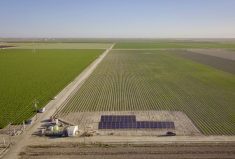He’s called “Dr. Food” for a reason, Dr. David Hughes is emeritus professor of food marketing at Imperial College London and also visiting professor at the UK’s Royal Agricultural University. In other words, he knows both sides — farm and food — and he knows business too, serving as advisory board member for food companies and financial service organizations on three continents. Dr. Hughes is among the most sought-after speakers on consumer and retail food trends on the planet, and earlier this fall, he headlined the A. Jean de Grandpré Lecture at McGill’s Macdonald Campus.
After his presentation, Dr. Hughes spoke with writer Anna Hobbs for Country Guide. An edited transcript follows:
CG: What can consumers do to solve today’s food problems?
DH: Climate-friendly and planet-friendly diets are gaining substantial traction. Just ask your children and grandchildren! This trend is being driven by students and young people who are looking at their food and saying, “How is it for the environment? How is it for my health?” Teen climate activist Xiye Bastida was lauded for a powerful speech to world leaders at (the) White House climate summit. Last December Greta Thunberg, speaking on climate crisis said,” We are speeding in the wrong direction.” WWF — the panda people — has a succinct one-liner: “The Power is on Your Plate,” reminding us that our food choices have environmental and health implications.
Read Also

A new spin on farm legacy
What does farm legacy look like for the next generation.
CG: What are the major food producers doing about health and environmental issues?
DH: For Nestlé, the future of food is rooted in plants. The Swiss-based company is investing heavily in its Sweet Earth brand and other plant-based offerings. In August 2020, the company launched a plant-based Vuna with the “rich flavour and flaky texture of tuna.” This September, it announced a C$1.6 billion investment in regenerative agriculture with its farming supply chain partners. Unilever wants to increase its annual sales of plant-based meat and dairy products five-fold in seven years and it’s well on-track, including its plant-based meat brand The Vegetarian Butcher, which it acquired two years ago and now sells in 30 countries.
CG: What can Canadian farmers do about consumer health and environment issues?
DH: Canadian farmers are brilliantly placed to take advantage of the healthy, “green” food trend that is sweeping the world. The Prairie provinces, in particular, have an exceptional international reputation for the principal raw materials underpinning the plant-based food mega-trend, namely grains, oilseeds and pulses.
“Fake” meat may be fashionable, but there is buoyant demand globally for premium beef and pork from transparent, traceable supply chains. Here though, there is need for Canadian livestock producers to work assiduously to reduce their carbon footprint.
In horticulture, a combination of expanding our share of our own market in-season and supplying our domestic market in the cooler parts of the year with high technology hydroponic systems offers a genuine fillip to local growers.
CG: Fast forward to 2050 when you predict there will be 9.8 billion people in the world and 80 per cent will be living in Africa and Asia. Can world agriculture meet the demand?
DH: There will be trouble if we don’t deal with climate change. FAO has forecasted climate change-induced declines in agricultural production for Africa and much of Asia, the regions that will see the lion’s share of the anticipated two billion additional people in the world. These regions are clearly a worry, and sea levels are rising and will continue to do so, reducing arable land, in Bangladesh, for example.
Canadian agriculture is well positioned to meet the demand, but it will not be a fair world. A portion of the world will have too little; a portion will have too much. Distribution will be the problem.
CG: What else must change if the world is to meet this target?
DH: Clearly, there needs to be an acceleration in agricultural productivity, particularly in emerging countries. We’ll see a fourth agricultural revolution, hopefully combining the very best regenerative practices along with a sensible dose of high technology such as drought- and flood-resistant gene-edited crops.
The notion of climate-friendly and planet-friendly agriculture is essential. We are already seeing developments in high-tech agriculture such as vertical farming, especially for salad crops, and climate-healthy milk. Goods will be sold based on their carbon footprint.
A major Swedish food company has launched its own grocery store where products are priced on their climate impact: the more the carbon dioxide emissions, the higher the price. Nestlé is packaging their confections in paper, not plastic. Last year, McCain Foods unveiled a raft of sustainable agriculture products.

CG: What are the drivers behind grocery price increases that we are experiencing today?
DH: Climate change and COVID-19. Grocery prices have been on a steady rise since the beginning of the pandemic. The FAO Global Food Price Index is at a 10-year high, and it is across all food commodities.
We haven’t seen anything yet. Food will likely get even more expensive. Everybody is concerned, but for different reasons. The lowest income group worries about getting food on their plates. The highest income group is cross because the price of ancient grain seeded sour-dough bread has increased from $4 to $5.
CG: What are the trends in grocery sales?
DH: Online sales peaked in 2020. They slipped slightly in 2021 but are still very strong. Canada started from a low base of online grocery sales in 2019. The pandemic certainly accelerated the trend but, because of the continued reluctance of many Canadians to buy their fresh food online, the current market share for online groceries is still at modest levels (maybe seven per cent).
Changes that are occurring at a great rate include:
- Rapid delivery of grocery essentials by companies such as Door Dash and Uber Eats.
- In the U.S. and U.K., Amazon has opened a new Fresh and Go store that features “Just Walk Out” checkout-free technology. Use your phone to scan and pay as you shop, then go.
- In Canada and the U.S., Walmart is working with Canadian firm Ghost Kitchen Brands where meals are prepared at the back of the superstores and can be sent to customers with their regular groceries, or a customer can come and pick them up personally.
- Meal kits featuring ready-to-eat meals oriented around health and wellness.
CG: Does this mean it is bye-bye grocery stores?
DH: No, but they need to be linked digitally and they need to have a big dollop of theatre. Supermarket chains in many Western countries have utilitarian stores that look and feel like big barns. Go to Asia to sample food emporia sprinkled with retail magic — Alibaba’s Freshippo (HEMA) in China is a great example.
CG: Are you concerned about food wastage?
DH: Yes. It is enormous. In 2019, household food waste in Canada was estimated at 79 kg/capita which is higher than the U.S. The Food Waste Index report helps countries track progress on UN Sustainable Development. Goal 2.3 is to halve food waste by 2030.
CG: What is being done about it?
DH: At Macdonald’s franchises throughout Latin America and the Caribbean, you’ll now get your food served on a tray made from an innovative new material — food waste. In Canada, the Flashfood app alerts subscribers to grocery stores that are slashing prices for fresh foods that are edging towards their “best before” dates, with opportunity to save tons of food that would have been destined for landfill.
CG: What effect has COVID-19 had on consumer food choices? Have people changed their diet during the pandemic?
DH: People around the world are more aware of healthy food items and they say they are eating healthier. But people have gained weight during the pandemic. Everywhere. We say we’re going to eat healthy, but we are not. Taste and convenience trump health. Every time. High-convenience products sell off the wall. One problem with this trend is that those who are overweight or obese are much more likely to be blown over by the pandemic.
CG: What is being done about this overeating/ unhealthy-eating trend?
DH: We will see increased governmental pressure on citizens to eat less, to eat healthier and to exercise more. We will see more regulation on health issues related to food — governments moving from nudging to taxing. In the U.K., a food strategy report recommends tax on the salt and sugar used in food processing. We can expect more warnings on food packaging — eye-jerking skull and cross bones and frightening medical pictures like the ones on Canadian cigarette packages. Also in the U.K., Smash, a health food discount app, is now available exclusively to 13- to 24 year-olds. Canada has its Healthy Eating Strategy but it’s still at the friendly “nudge” stage. Obesity costs Canada and Canadians $9 billion and thousands of deaths per year. Most of us don’t like a nanny state but taxpayers need to push government to be more forceful. Threaten the food industry with fat, sugar and salt taxes and manufacturers will change their ingredient mixes to avoid paying the taxes! In the spring of 2022, regulations are to be introduced in the U.K. on junk food advertising on TV. This is highly controversial, not least because it depends on the definition of junk food — or tasty treat! — Consumers need to recognize that over-consumption of red and processed meats increases the risk to both human health and the environment. Plant foods tend to be good for both people and the planet. But remember, a little bit of what you fancy is good for you!















